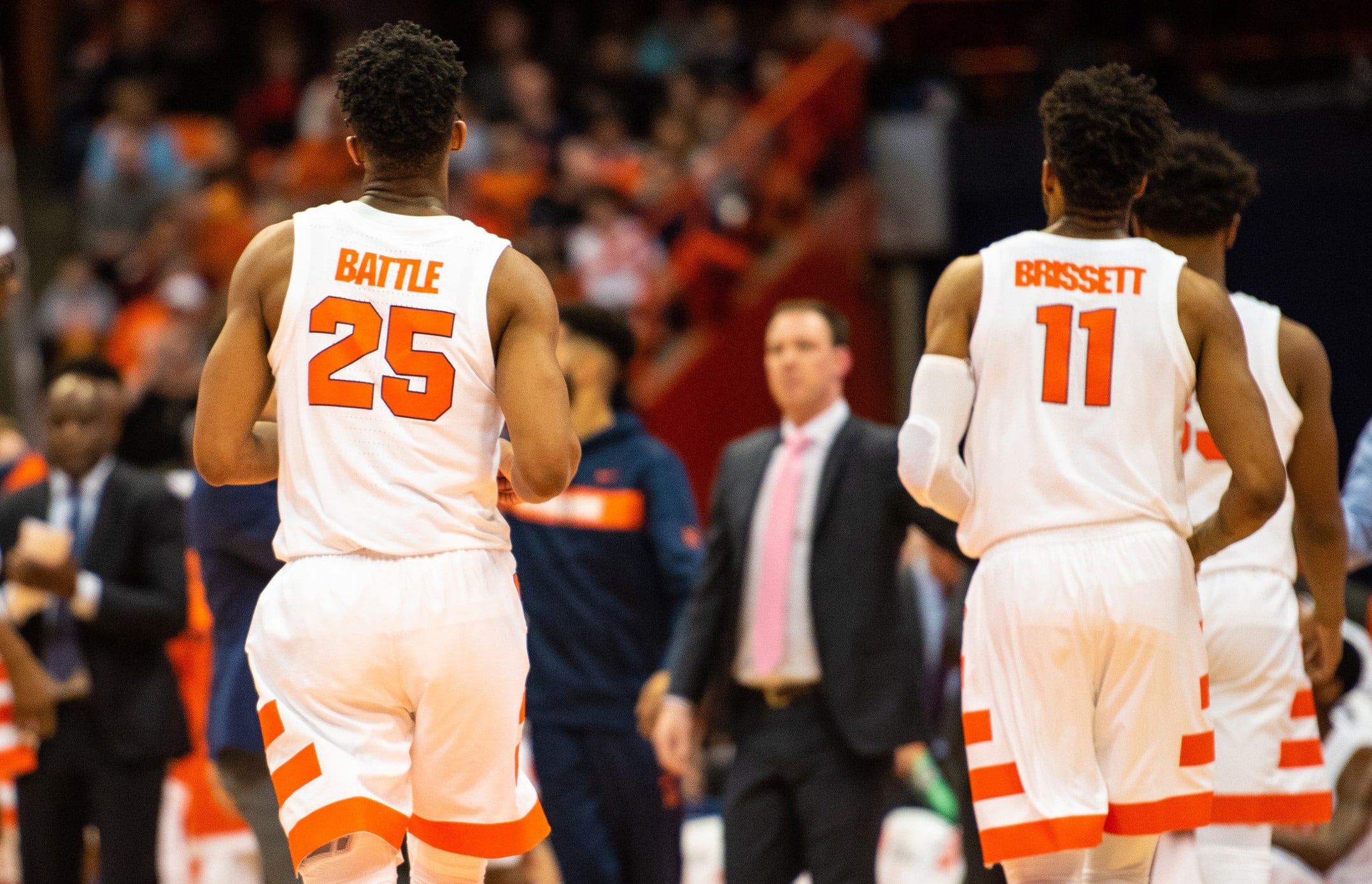Offseason moves: Battle and Brissett head to NBA draft
Offseason moves: Battle and Brissett head to NBA draft

Between the coaching carousel, the NBA draft, recruiting and offseason foreign trips, college basketball has truly become a 12-month sport. Syracuse is no exception.
Despite the final buzzer on the Orange’s season having sounded nearly a month ago after a first-round NCAA Tournament loss to Baylor, Syracuse fans still have plenty to keep track of during the “offseason.” At, or most certainly near, the top of that list this year are the potential NBA draft prospects: Tyus Battle and Oshae Brissett.
Battle, the 6’6” guard who has led the Orange in scoring with 18.2 points per game the past two seasons, has already decided to forgo his final season of college eligibility and is certain to keep his name in the draft after testing the process last year but opting to return to school.
Despite his productivity during three years at Syracuse, Battle remains a bit of an enigma to NBA scouts and draft analysts who widely project him as either a late second-round pick or an undrafted prospect who will have to fight his way onto an NBA roster.
“He was the most divisive prospect within my coaches poll survey outside of Nassir Little, in large part because it’s unclear how he affects the game outside of scoring,” wrote Sam Vecenie, NBA draft analyst at The Athletic. He was referencing a project in which he interviewed 50 college basketball coaches about various NBA draft prospects across the country.
Vecenie later ranked Battle as the 63rd-best prospect in the draft in his most recent big board, just outside the draft range of 60 players.
As Vecenie notes, scouts point to Battle’s lack of production besides his scoring and the questionable consistency of his jump shot as reasons why he is not a surefire NBA player. One scout pointed to the context of his career at Syracuse as providing complications to evaluating exactly how he projects as a player.
“His sophomore year, it was interesting. He was super productive but super high-usage, and in my opinion he was not really used in the way his NBA role would project at, just being a guy you’re just counting on every time down the floor,” said Matthew McKay, an NBA draft analyst for Babcock Hoops who previously worked in the front offices of the Charlotte Hornets and Portland Trail Blazers.
“But at the same time, you still see some things that translate: positional size on the perimeter, ball skills as a 6’6” guy, and kind of scoring from all over,” McKay said.
McKay noted last year’s NBA Draft Combine as the point where teams started to sour on Battle due to a shaky performance. While Battle showed improvements as a junior, McKay said, they weren’t necessarily to the extent that NBA front offices wanted to see from him.
As a 21-year-old junior being compared to primarily underclassmen, he is also seen to lack a degree of upside that some younger, less proven prospects have.
“One thing I was looking for from him coming into his junior year was just becoming a little more efficient with his touches,” McKay said. “Numbers-wise, he did do that. Look at his game log across the board and he made some strides in some areas, probably not as substantial as you may have liked to see ideally. But I think he kind of is what he is at this point. I don’t think there’s an incredible amount of upside.”
What Battle has going for him are his size for the shooting guard position at 6’6” with solid length and strength, as well as the frame that could allow him to guard both wing positions in the NBA — a skill heavily valued in today’s league.
McKay pointed to Brooklyn Nets swingman Treveon Graham as a potential model for Battle’s NBA career. Graham went undrafted out of Virginia Commonwealth University in the 2015 draft but clawed his way onto the Hornets roster and has now established a legitimate role in the league.
“Treveon just came in and made the roster by playing his butt off, knocking down open shots, taking on tough physical defensive assignments and being a great teammate,” McKay said. “Anybody can use a 6’6” guard who can hit shots and play hard, so [Battle] has a lot going for him. Now he just has to make one team fall in love with him. That’s his job at this point.”
Oshae Brissett, on the other hand, is looking more likely to be back in Orange next season. With recent changes to the draft process, underclassmen are able to workout for NBA teams and get feedback on their prospects while still maintaining their college eligibility.
While Brissett has declared his intentions to “test the waters” of the draft process, he will have until May 30 to decide whether or not to return to school.
“I don’t fault Oshae for taking advantage of this ‘testing the waters’ process, because the way the dynamics are set up, it’s totally player-friendly,” McKay said. “You may as well go through this process and get official feedback. I would imagine that that feedback is going to be, ‘Go back to school and become a more efficient basketball player.’”
McKay points to Brissett’s field goal percentage of 39.3 this season and his lack of a clear NBA role as reasons the 6’8” sophomore forward is not currently a draftable prospect. While some projections at the beginning of the season forecasted Brissett as a potential first round selection, following a promising finish to his freshman season, he is not currently projected to be picked by any of the major draft sites.








